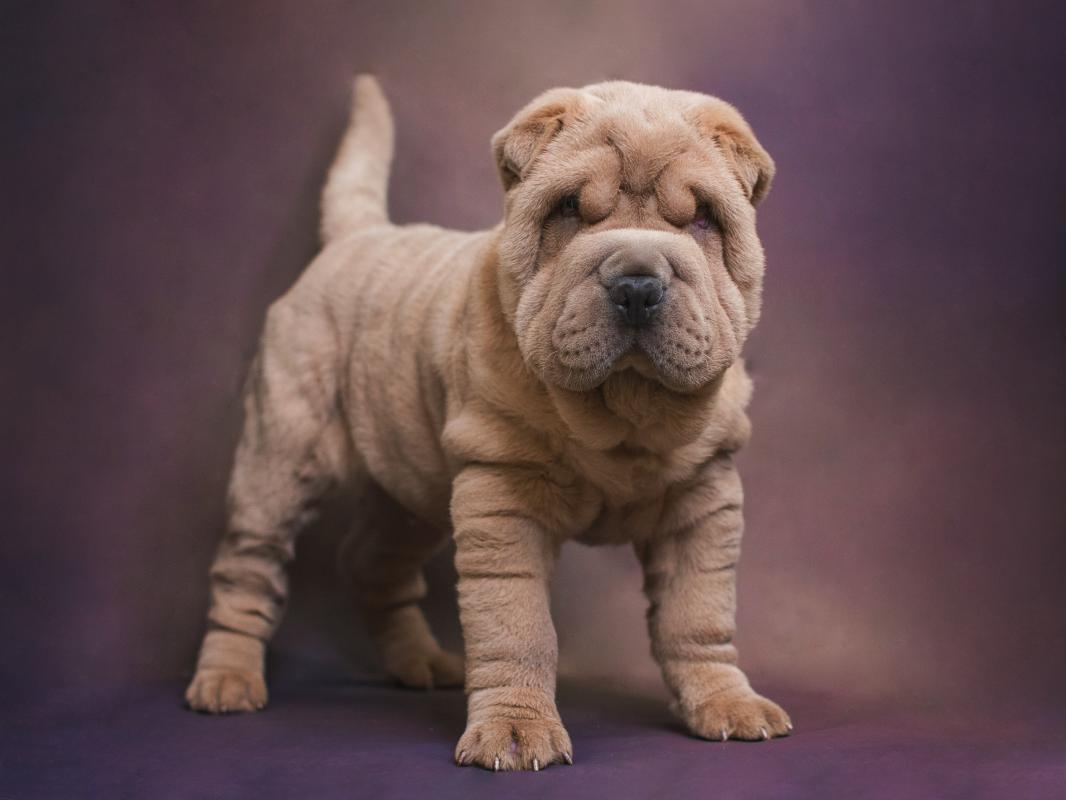Combining a loving, loyal demeanor with a strong independent streak, Shar-Pei puppies are the perfect choice for a family dog.
Originally bred for guarding, hunting and herding, the Chinese Shar-Pei became popular in recent years for its cuddly, wrinkled appearance. Aside from their loose, wrinkled skin, Shar-Peis are known for their "hippo-like" face with deep set wrinkles and fleshy muzzle and solid blue-black tongue. Looks aside, this is a breed known for being affectionate, loving, alert, intelligent and courageous, making it both a great family dog and guard dog. They also have a distinct stubborn streak, which can make training a challenge and may not make them ideal for first time dog owners. Their name translates as "sand skin", a reference to their distinctive bristle coat, which can be either "horse coat" (short and bristly) or "brush-coat" (slightly longer and smoother) and comes in black, cream, fawn, red, sable and blue. Both males and females stand between 18 to 20 inches and weigh between 40 and 55 pounds.
History
Originating in the southern provinces of China, the breed was originally used as a hunter, herder and guardian on farms. Unfortunately, the breed’s natural protective streak and strength were exploited and it was eventually used for fighting. After the creation of the People’s Republic of China, the dog population in the country was almost completely wiped out but Shar-Peis continued to be bred in Hong Kong and Taiwan. Eventually a small number of Shar-Peis were brought to the United States in 1973. The Shar-Pei was accepted into the American Kennel Club Miscellaneous Class in 1988 and was eventually recognized as a member of the Non-Sporting Group in 1991.
Temperament
Shar-Peis are known to be loyal and protective, making them wonderful guard dogs. They also have a distinct independent streak that can make them aloof with strangers. Early socialization is essential in order to ensure good behavior around people outside of the family. Their previous history as fighters can make them aggressive toward other dogs but again, early socialization can help. Shar-Peis can be wonderful with children and other dogs, particularly if they have been raised together, but generally do better with older children who are more respectful..
Environment
This breed is calm and not overly active, so they are adaptable to various living arrangements, including apartments, however if you’re living in close quarters you may need to be aware of their tendency to bark. In most cases, the Shar-Pei is just happy being with his family. This should also help to make socialization easier as he will be eager to go with you wherever you may be. They don’t require a yard to run around in but should regularly get out and stretch their legs.
Exercise
Exercise needs are relatively simple with this breed. The Shar-Pei requires daily exercise but it doesn’t have to be vigorous or lengthy. A walk around the neighborhood will usually suffice, but remember to always keep your Shar-Pei on the leash as his aggressive streak could become problematic when he encounters other dogs. Because of their short muzzle, you should be careful to avoid exercising them too much in hot weather.
Grooming
With their short, bristly coat, Shar-Peis are not heavy shedders and don’t require a lot of regular grooming. A thorough brushing with a grooming mitt once a week is usually enough to remove dead hair and dirt. Bathing is usually only required about once every 12 weeks, but when you bathe your Shar-Pei it is essential that you very carefully dry all those folds and wrinkles in order to avoid a yeast or fungal infection. Brush their teeth two or three times a week and trim his nails once or twice a month. You should also check their ears weekly to ensure there are no signs of infection.

 Model Puppy Shown
Model Puppy Shown